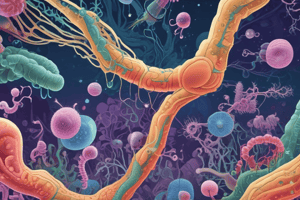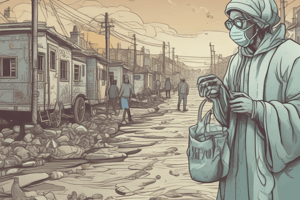Podcast
Questions and Answers
Which of the following is NOT a virulence factor of Vibrio cholerae?
Which of the following is NOT a virulence factor of Vibrio cholerae?
- Flagellar proteins
- Hemagglutinin
- Cholera toxin
- Cytotoxins (correct)
What is the primary effect of the Cholera toxin A subunit interacting with cytosolic ARFs?
What is the primary effect of the Cholera toxin A subunit interacting with cytosolic ARFs?
- It blocks the CFTR channel
- It promotes Cl and Na absorption
- It activates the Gsa subunit (correct)
- It inhibits adenylate cyclase
In severe cases of Cholera, which clinical feature is most characteristic?
In severe cases of Cholera, which clinical feature is most characteristic?
- Constipation with bloody stools
- Fever and localized abdominal pain
- Rice water stool with fishy odor (correct)
- Formation of crypt abscesses
Which disease exhibits mucosal and intraepithelial infiltrates, as well as cryptitis and crypt abscesses?
Which disease exhibits mucosal and intraepithelial infiltrates, as well as cryptitis and crypt abscesses?
Which of the following best describes the pathogenesis of Cholera in the small intestine?
Which of the following best describes the pathogenesis of Cholera in the small intestine?
What is the role of hemagglutinin in the pathogenesis of Cholera?
What is the role of hemagglutinin in the pathogenesis of Cholera?
What is a key morphological feature that distinguishes Cholera from C. difficile colitis?
What is a key morphological feature that distinguishes Cholera from C. difficile colitis?
Which of these best describes the primary reservoir for Campylobacter jejuni?
Which of these best describes the primary reservoir for Campylobacter jejuni?
What is the initial step in the pathogenesis of Campylobacter jejuni infection, once in the host?
What is the initial step in the pathogenesis of Campylobacter jejuni infection, once in the host?
Which of the following is a hallmark histopathological finding in Campylobacter enterocolitis?
Which of the following is a hallmark histopathological finding in Campylobacter enterocolitis?
What is a potential extraintestinal complication associated with Campylobacter jejuni infection?
What is a potential extraintestinal complication associated with Campylobacter jejuni infection?
In the context of the provided information, what is a major difference in the pathogenesis of Campylobacter jejuni compared to Yersinia infection? (as shown in the text).
In the context of the provided information, what is a major difference in the pathogenesis of Campylobacter jejuni compared to Yersinia infection? (as shown in the text).
What is the most likely setting for a Campylobacter jejuni infection to occur?
What is the most likely setting for a Campylobacter jejuni infection to occur?
Which of the following cell types is involved in the host response in both Campylobacter and Yersinia infections?
Which of the following cell types is involved in the host response in both Campylobacter and Yersinia infections?
What is a clinical sign that can be associated with both Campylobacter and Yersinia infections based on the text provided?
What is a clinical sign that can be associated with both Campylobacter and Yersinia infections based on the text provided?
In contrast to EHEC O157:H7 infection, what specific feature regarding host cells is described in the pathogenesis of Campylobacter?
In contrast to EHEC O157:H7 infection, what specific feature regarding host cells is described in the pathogenesis of Campylobacter?
Which of the following is a characteristic feature of Enteroinvasive E. coli (EIEC) infection?
Which of the following is a characteristic feature of Enteroinvasive E. coli (EIEC) infection?
What is the primary reservoir for Shigella species?
What is the primary reservoir for Shigella species?
What is the significance of M cells in the pathogenesis of Shigella infection?
What is the significance of M cells in the pathogenesis of Shigella infection?
Which of the following is NOT a virulence factor of Shigella species?
Which of the following is NOT a virulence factor of Shigella species?
What is a typical symptom associated with Shigella infection?
What is a typical symptom associated with Shigella infection?
What is the most appropriate treatment approach for Salmonella enteritidis infection?
What is the most appropriate treatment approach for Salmonella enteritidis infection?
How does Salmonella enteritidis enter host cells in the small intestine?
How does Salmonella enteritidis enter host cells in the small intestine?
What effect does bacterial flagellin have during a Salmonella infection?
What effect does bacterial flagellin have during a Salmonella infection?
Which site is primarily affected by Shigella infection?
Which site is primarily affected by Shigella infection?
Which of these is a potential complication of Shigella infection?
Which of these is a potential complication of Shigella infection?
Which of the following is NOT a typical symptom associated with Yersinia infections?
Which of the following is NOT a typical symptom associated with Yersinia infections?
What is the primary function of the iron uptake system in Yersinia species?
What is the primary function of the iron uptake system in Yersinia species?
What is the direct effect of the heat-labile toxin (LT) produced by pathogenic bacteria?
What is the direct effect of the heat-labile toxin (LT) produced by pathogenic bacteria?
Which of the following factors contributes to enhanced Yersinia virulence, stimulating systemic dissemination?
Which of the following factors contributes to enhanced Yersinia virulence, stimulating systemic dissemination?
Which of the following methods of transmission is NOT primarily associated with Yersinia infections according to the text?
Which of the following methods of transmission is NOT primarily associated with Yersinia infections according to the text?
What is the primary route of transmission for S. typhi in endemic regions?
What is the primary route of transmission for S. typhi in endemic regions?
Which organ is a reservoir for S. typhi, leading to potential reinfection?
Which organ is a reservoir for S. typhi, leading to potential reinfection?
What is a common complication associated with Salmonellosis resulting from S. typhi?
What is a common complication associated with Salmonellosis resulting from S. typhi?
Which of the following is a characteristic histological finding in the liver during a S. typhi infection?
Which of the following is a characteristic histological finding in the liver during a S. typhi infection?
Which of the following is a distinguishing feature of S. paratyphi infections compared to S. typhi?
Which of the following is a distinguishing feature of S. paratyphi infections compared to S. typhi?
Which of the following best describes the initial febrile phase of S.typhi?
Which of the following best describes the initial febrile phase of S.typhi?
What is the significance of B-1 integrins in the context of Yersinia infection?
What is the significance of B-1 integrins in the context of Yersinia infection?
In addition to the ileum and right colon, which other site is commonly affected by Yersinia infection?
In addition to the ileum and right colon, which other site is commonly affected by Yersinia infection?
Which of the following conditions can Yersinia infection mimic?
Which of the following conditions can Yersinia infection mimic?
What are common animal reservoirs for Yersinia infections?
What are common animal reservoirs for Yersinia infections?
Flashcards
Cholera
Cholera
A bacterial infection that causes severe watery diarrhea, commonly known as "rice water stool".
Cholera Toxin
Cholera Toxin
A toxin produced by Vibrio cholerae, composed of two subunits: A and B. Subunit B binds to GM1 ganglioside on intestinal cells, allowing subunit A to enter the cell and activate adenylate cyclase, leading to increased cAMP levels and fluid secretion.
Vibrio cholerae
Vibrio cholerae
The bacterium responsible for cholera, a Gram-negative, comma-shaped bacterium.
Pathogenesis
Pathogenesis
Signup and view all the flashcards
Morphology
Morphology
Signup and view all the flashcards
Clinical Features
Clinical Features
Signup and view all the flashcards
Reservoir
Reservoir
Signup and view all the flashcards
Shigellosis
Shigellosis
Signup and view all the flashcards
Salmonellosis
Salmonellosis
Signup and view all the flashcards
What is Campylobacter enterocolitis?
What is Campylobacter enterocolitis?
Signup and view all the flashcards
What is cryptitis?
What is cryptitis?
Signup and view all the flashcards
What is crypt abscess?
What is crypt abscess?
Signup and view all the flashcards
What is invasion of the enterocyte?
What is invasion of the enterocyte?
Signup and view all the flashcards
What is Guillain-Barré syndrome?
What is Guillain-Barré syndrome?
Signup and view all the flashcards
What is ulcerative colitis?
What is ulcerative colitis?
Signup and view all the flashcards
What is gastroenteritis?
What is gastroenteritis?
Signup and view all the flashcards
What is food poisoning?
What is food poisoning?
Signup and view all the flashcards
What is reactive arthritis?
What is reactive arthritis?
Signup and view all the flashcards
Salmonella and Shigella
Salmonella and Shigella
Signup and view all the flashcards
What is S.typhi?
What is S.typhi?
Signup and view all the flashcards
How does Typhoid fever spread?
How does Typhoid fever spread?
Signup and view all the flashcards
How does S.typhi infect the body?
How does S.typhi infect the body?
Signup and view all the flashcards
What happens after S.typhi infects the intestines?
What happens after S.typhi infects the intestines?
Signup and view all the flashcards
How can Typhoid fever re-infect a person?
How can Typhoid fever re-infect a person?
Signup and view all the flashcards
What are the symptoms of Typhoid fever?
What are the symptoms of Typhoid fever?
Signup and view all the flashcards
What causes Yersiniosis?
What causes Yersiniosis?
Signup and view all the flashcards
What are the symptoms of Yersiniosis?
What are the symptoms of Yersiniosis?
Signup and view all the flashcards
How does Yersinia bacteria infect the body?
How does Yersinia bacteria infect the body?
Signup and view all the flashcards
What are the extraintestinal symptoms of Yersiniosis?
What are the extraintestinal symptoms of Yersiniosis?
Signup and view all the flashcards
Study Notes
Bacterial Enterocolitides
-
Cholera:
- Agent: Vibrio cholerae
- Morphology: Minimal histologic alterations, no invasion, remains in the lumen.
- Pathogenesis: Flagellar proteins cause motility and attachment, cholera toxin (A and B) causes disease, toxin B binds to GM1 ganglioside, toxin A subunit interacts with cytosolic proteins, activating adenylate cyclase, increasing cAMP, blocking CFTR, and leading to Cl and Na absorption, accumulation of Cl ions, secretion of bicarbonate and Na, and massive diarrhea.
- Clinical features: Mostly asymptomatic in mild cases, severe cases present with rice water stool with a fishy odor.
- Location: Endemic in India and Africa, transmission through contaminated water and fecal-oral contact. Shellfish and plankton are reservoirs.
-
Campylobacter enterocolitis:
- Agent: Campylobacter jejuni
- Pathogenesis: Flagella, cytotoxins, invasion. Organisms attach and proliferate, endocytosis, exit, and invasion of next enterocyte.
- Clinical features: Acute self-limiting colitis, food poisoning, traveler's diarrhea, possibly dysentery. In severe cases, may show symptoms matching conditions like reactive arthritis, erythema nodosum, and Guillain-Barré syndrome (flaccid paralysis) in some patients with HLA-B27.
- Location: Reservoir includes chicken, sheep, pigs, cattle; Transmission: ingestion of improperly cooked chicken.
-
Shigellosis:
- Agent: Shigella spp.
- Morphology: Mucosa hemorrhagic and granular.
- Pathogenesis: Virulence factors, invasion, and inflammation cascade.
- Clinical features: Affected site: Left colon and ileum, reservoir: Humans.
- Location: Reservoir: Humans.
Other Bacterial Infections
-
Salmonellosis:
- Agent: Salmonella enteritidis
- Pathogenesis: Virulence factors (flagella, bacterial LPS), bacterial growth in endosomes, activation of TLR5 and TLR4, intense inflammation, and mucosal damage.
- Clinical features: Commonly, self-limiting infection. Severe cases can lead to complications like osteomyelitis in susceptible populations.
- Location: Reservoir: humans, animals; transmission: food, raw meat, poultry.
-
Typhoid fever:
- Agent: Salmonella enterica (S. typhi, S. paratyphi)
- Pathogenesis: Organisms taken up by M cells, invasion of M cells, and systemic reactive hyperplasia of phagocytes. S. typhi reside in the gallbladder.
- Clinical features: Initial dysentery, followed by asymptomatic phase, bacteremia in severe cases, possible complications like abdominal tenderness, rose spots.
- Location: Reservoir: humans, Transmission: contaminated food or water, person to person.
Viral Gastroenteritis
-
Norovirus:
- Single-stranded RNA.
- Common cause of nonbacterial gastroenteritis.
- Self-limiting in immunocompetent individuals.
- Transmission: Contaminated food, water, airborn droplets
-
Rotavirus:
- Double-stranded RNA.
- Most common cause of severe childhood diarrhea.
- Low infective dose, in some regions, maternal antibodies are ineffective in the first six months of a child's life.
-
Adenovirus:
- Most common cause of pediatric diarrhea, often self-limiting.
-
Ascaris lumbricoides:
- Parasitic infection, if disseminated, can result in hepatic abscesses, potentially leading to pneumonia.
- Transmission: human fecal-oral, contaminated water.
Further Bacterial Infections
-
Yersinia:
- Agent: Y. enterocolitica, Y. pseudotuberculosis, Y.. pestis
- Pathogenesis:Yersinia binds to B-1 integrins, iron uptake system mediates iron capture and transport.
- Clinical Feature Mimic acute appendicitis, extraintestinal symptoms, Pharyngitis, arthritis, Erythema nodosum, Chronic anemia, and hemochromatosis.
- Reservoirs: Cattle, Pigs, and other mammals, transmitted through contaminated food or water.
-
Enterotoxigenic E. coli (ETEC):
- Pathogenesis: Heat-labile toxin (LT), and heat-stable toxin (ST), activates adenylate cyclase, increased cAMP and cGMP, leads to fluid secretion.
- Clinical Features: Watery diarrhea.
- Reservoirs: Cows, transmission: contaminated food.
-
Enteropathogenic E. coli (EPEC):
- Pathogenesis: Adherent effacing (A/E) lesions, proteins in the cytoplasm to attach to cells.
- Clinical Features: Infant's diarrhea.
-
Enterohemorrhagic E. coli (EHEC):
- Pathogenesis: Shiga-like toxins (STx) activate adenylate cyclase.
- Clinical Features: Bloody diarrhea (possible HUS in some cases), ischemic colitis.
- Reservoirs: Cows
-
Enteroinvasive E. coli (EIEC):
- Pathogenesis: Invasion of epithelial cells.
- Clinical Features: Bloody diarrhea.
-
Enteroaggregative E. coli (EAEC):
- Pathogenesis: Attachment to enterocytes, similar to Shigella.
- Clinical Features: Non-bloody diarrhea.
Protozoal Infections
-
Cryptosporidium:
- Agent: Cryptosporidium spp.
- Pathogenesis: Oocyst, secretes proteases, releases sporozoites, damages brush-border. Na malabsorption, secretion of Cl leads to diarrhea.
- Clinical Features: Self-limiting diarrhea in immunocompetent persons; Chronic diarrhea in immunocompromised persons.
- Transmission: Contaminated drinking water, fecal-oral transmission
-
Strongyloides:
- Agent: Strongyloides spp.
- Pathogenesis: Filariform larvae is infective stage. Self-sustaining infection, auto-infection
- Clinical Features: Mucosal damage, iron deficiency anemia, intense irritation, and pruritus, bloody diarrhea.
- Transmission: Fecal-oral, ingestion
-
Schistosoma:
- Agent: Schistosoma spp.
- Pathogenesis: Cercariae from snails can penetrate skin, granulomatous reaction.
- Clinical Features: Granulomatous reaction, bleeding and obstruction.
-
Diphyllobothrium latum:
- Pathogenesis: Larval stage, infection persists, mucosal damage, possible vitamin B12 deficiency.
- Clinical Features: Megaloblastic anemia in severe cases possible, possible obstruction/bleeding.
-
Taenia solium:
- Pathogenesis: Cysticercus stage.
- Clinical Feature: Gravid proglottids in feces, presence of cysticerci in muscles of pork, can lead to neurological complications.
-
Hymenolepis nana:
- Pathogenesis: Eggs passed in feces.
- Clinical Features: Cysticercoid in arthropods (in some cases).
-
Entamoeba histolytica:
- Pathogenesis: Flask shaped ulcer, invasion and destruction of the colonic epithelium.
- Clinical Features: Amebiasis, potentially life-threatening.
-
Giardia lamblia:
- Pathogenesis: Duodenal trophozoites, cysts.
- Clinical Features: Diarrhea, usually self-limiting.
Pseudomembranous Colitis
- Agent: Clostridium difficile
- Pathogenesis: Antibiotics disrupt normal colonic flora leading to C. difficile overgrowth, toxin release damaging epithelial cells, inflammation and pseudomembrane formation.
- Clinical Features: Antibiotic-associated colitis/diarrhea, protein loss, hypoalbuminemia, watery diarrhea.
Whipple Disease
- Agent: Tropheryma whipplei
- Pathogenesis: Distended foamy macrophages with PAS-positive granules.
- Clinical Features: Arthritis, fever, lymphadenopathy.
Studying That Suits You
Use AI to generate personalized quizzes and flashcards to suit your learning preferences.





